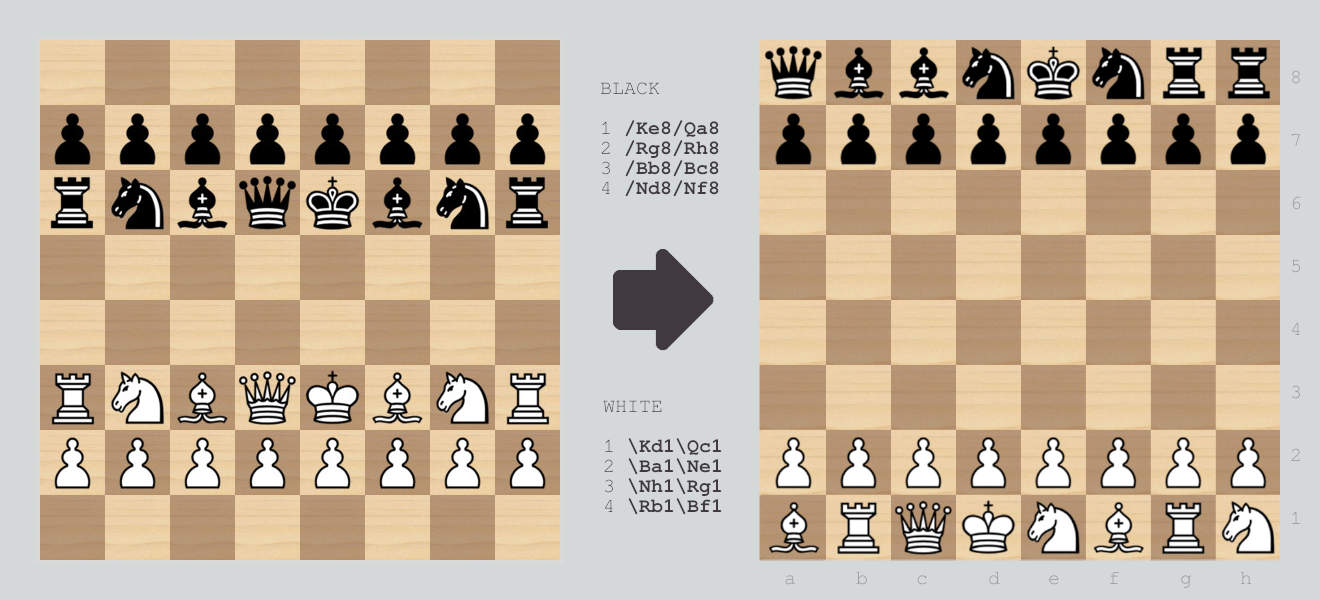Field Chess
Field Chess is a chess variation designed to add more flavor to traditional chess.
In Field Chess, players set up their pieces with extra moves, as if generals were 'fielding' their armies before battle.

FIELDING PHASE
Over a series of four moves, each player will take a turn 'fielding' two pieces, setting them on their back rank.
SET UP
- Each Player sets up their 8 Pawns as in Traditional Chess on rows 2 for White and 7 for Black
- For professional/tournament style games, the remaining pieces can be set up on rows 3 for White and 6 for Black
- For casual games, the remaining pieces may be left off the board instead
- If players wish to play traditional chess, they may simply field their pieces in the traditional arrangement
FIELDING TURNS
- White Places King on row 1 space either d1 or e1, and the Queen on any remaining space on row 1 (ex: \Kd1\Qf1)
- Black follows places King on d8 or e8, and then the Queen on row 8 (ex: /Ke8/Qb8)
- White places any two remaining pieces on row 1 (ex: \Ra1\Be1)
- Black places any two remaining pieces on row 8 (ex: /Ba8/Nd8)
- White places any two remaining pieces on row 1
- Black places any two remaining pieces on row 8
- White places last two remaining pieces on row 1
- Black places last two remaining pieces on row 8
- Fielding has Ended - Commence Battle!
BISHOPS
- Bishops for each side must result in placement on different color squares.
- A fielding move MUST be taken with a bishop if only one remaining color square for it is left exposed.
CASTLE
- Castling is done by moving the king up to two (or at least one) squares (whichever is longer to the rook in unoccupied spaces), and placing the rook on the other side of the king.
NOTATION
The notation of placement is \ for white and / for black and is recommended to be written in column order.
A full line of notation for a move looks like:
However, this may be condensed in the following way to save time:
Placements which can be deduced from preceding turns and moves may have their column names omitted from notation (example: two rooks are placed last by black, black could write /R/R)
TRADITIONAL SHORTHAND
If both players agree to traditional placement, they may forgo their four fielding notation lines and write only \T in the first line to signify traditional placement of \Ra\Nb\Bc\Qd\Ke\Bf\Ng\Rh (or /T); or, the further shorthand of writing only \ or /, or even a blank line would be interpreted as traditional.
NOTES
- Inspired by the comment made by Bobby Fischer, to lessen the importance of memorizing opening moves in chess. While also not adding randomness/luck to the game.
- In tournaments, fielding turns use clocked time just as regular chess turns.
- A small amount of additional time could be added to players total time to account for fielding moves.
- A "Move" is defined as in the traditional chess terminology as a turn by White followed optionally with a turn by Black
- A "Turn" is defined as one of the two turns taken by White or Black during a "Move"
- A "Fielding Turn" is the fielding placement of two pieces by a player (i.e. a turn)
- A "Fielding Placement" is the fielding placement of one piece by a player (i.e. half a turn)
- A "Fielding Move" is a series of fielding turns by White and then by Black (i.e. two turns)
OPTIONAL: SINGULAR VARIATION
After White fields the King during the first turn,
White may offer Black to place their King. If Black accepts,
then fielding proceeds with one fielding placement per turn instead of two,
thus creating 8 fielding moves instead of 4.
If Black declines, White places the Queen as usual.
In timed games, White can force singular mode by hitting their clock after fielding their King,
or White can force regular mode by placing King and Queen and hitting their clock.
Therefore, in timed games, verbal agreements are secondary to White's action.
For tournaments this mode must be specified as enabled before entering.
Invented by David Kerr 2020
This work is licensed under CC BY-SA 4.0
